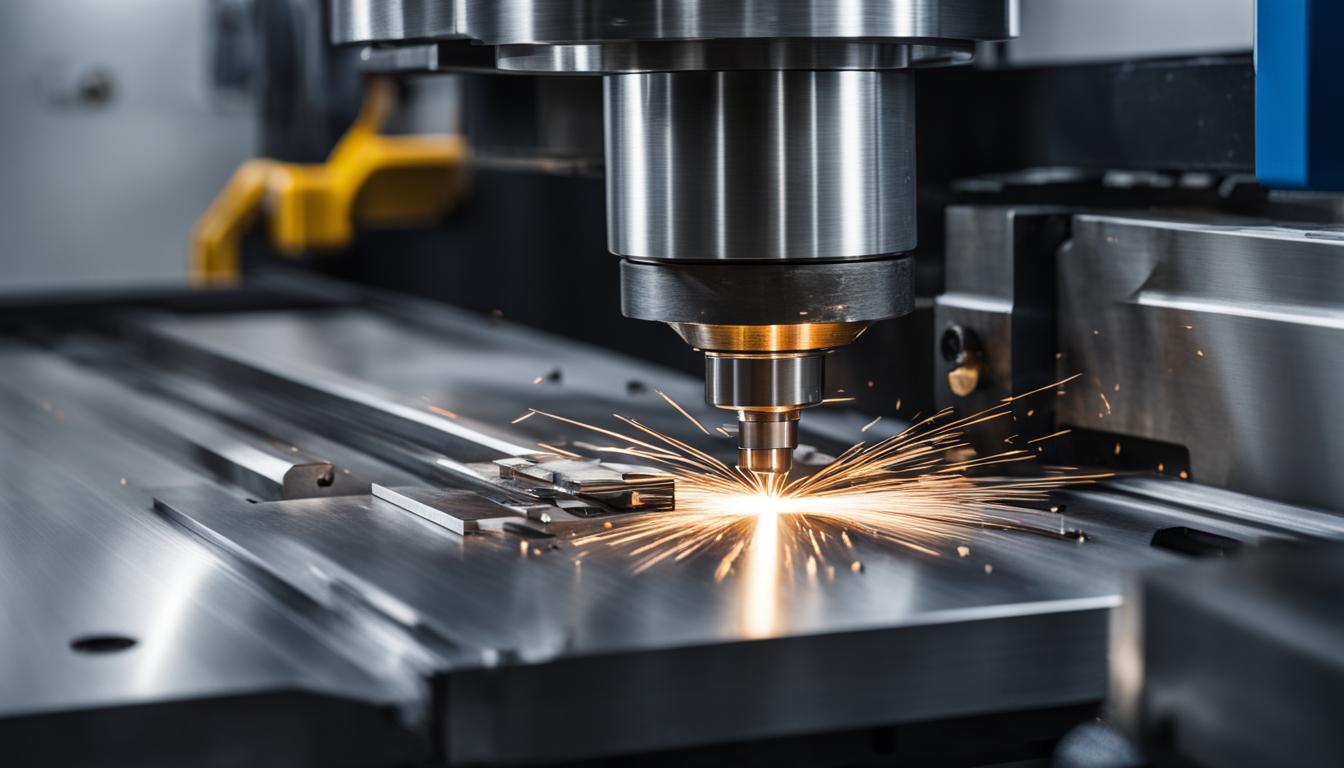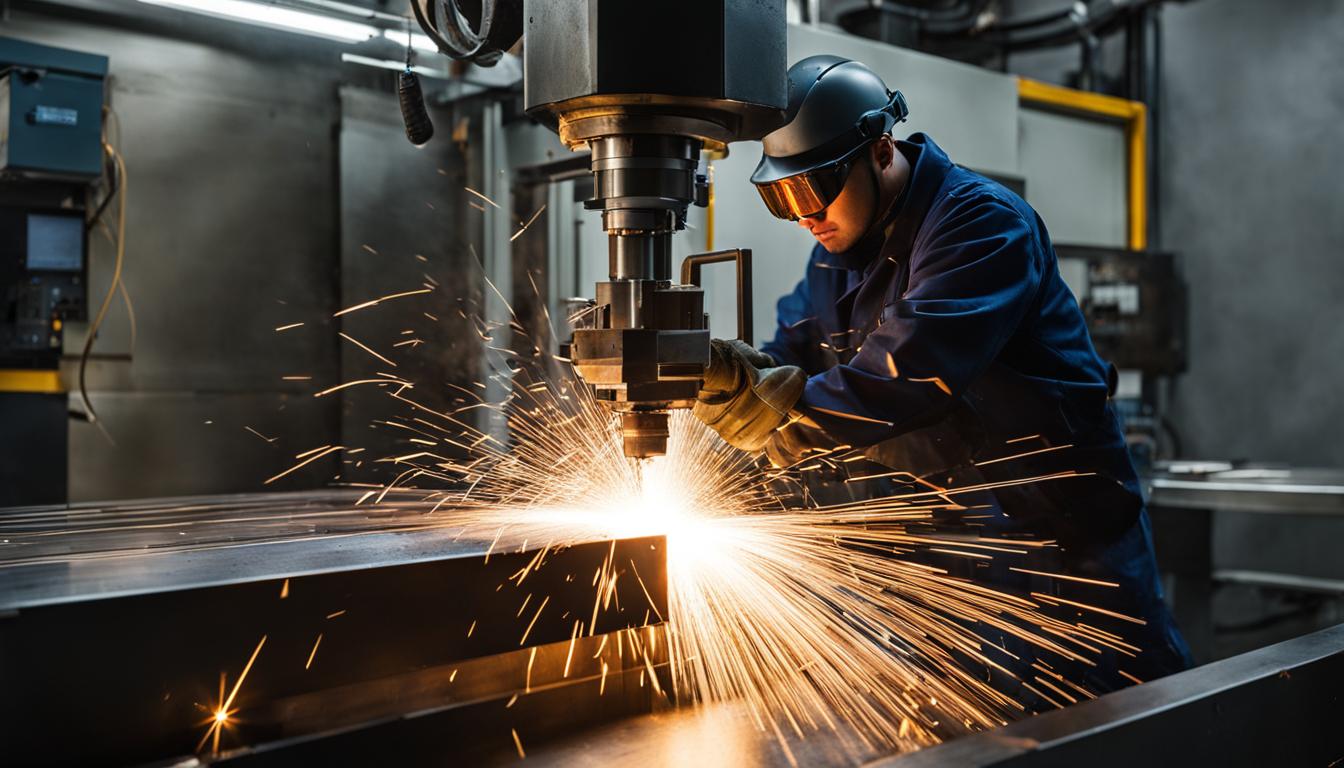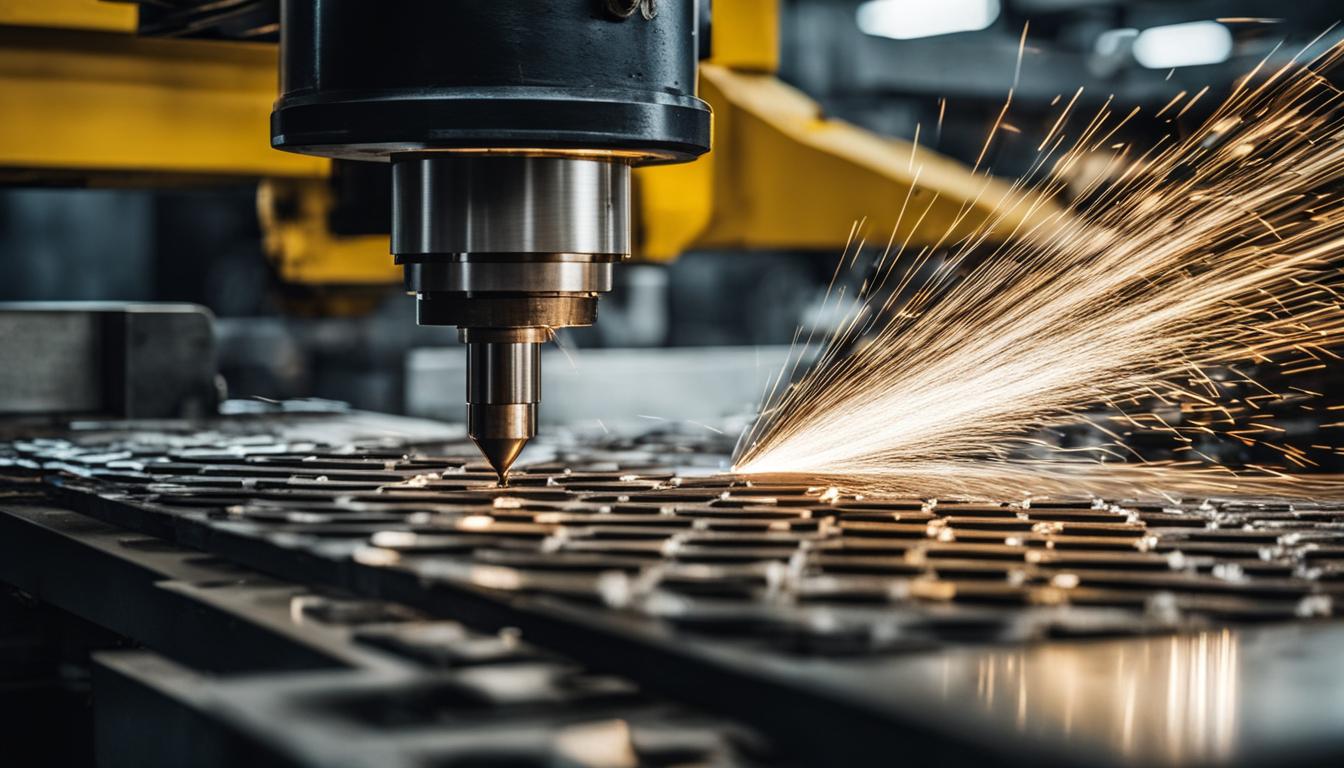CNC machining is a widely used method for mass producing metal and plastic parts in industries like aerospace. It offers precision and automation, eliminating the risk of human error. CNC machines work by following programmed instructions and can use multiple tools simultaneously. The most common CNC machine language is G-code. CNC machines can be classified into different types such as CNC mills, CNC turning centers, plasma cutters, and water jet cutters. Popular machining techniques include roughing and semi-finish machining, turning, milling, and solid sink EDM.
- CNC machines offer precision and automation, reducing the risk of human error in mass production.
- G-code is the most commonly used language for CNC machines.
- There are various types of CNC machines, each with its own specialization.
- Machining techniques like roughing, turning, milling, and solid sink EDM are commonly used in CNC machining.
- CNC machining is essential for industries that require high precision and efficient manufacturing processes.
What is CNC Machining?
CNC machining is a modern manufacturing process that utilizes programmed instructions to direct the cutting of a workpiece. Unlike manual machining, CNC machining is not limited to one tool or machinery. In fact, CNC machines can use multiple tools simultaneously, making the process more efficient and versatile.
The term “numerical control” refers to the automated control of the machining process. This means that CNC machines follow programmed instructions and do not require constant manual intervention. This automation reduces the risk of human error and ensures consistent and precise machining results.
The most commonly used language for CNC machines is G-code. G-code contains specific commands that control the movement and actions of the machine. Additionally, M-code is also used to control auxiliary functions and monitor machine status.
CNC machines offer numerous advantages over manual machining. They provide higher precision and accuracy, allowing for the production of complex and intricate parts. By eliminating the need for manual intervention, CNC machines also reduce the risk of errors, resulting in higher-quality products.
How Does CNC Machining Work?
To operate a CNC machine, a skilled professional must program the computer with the instructions for the machining process. The machine reads and executes the program, controlling various tools and fabrication processes. CNC machines require advanced computer programming, and the most common software used is computer-aided manufacturing (CAM) software. This software can turn a computer-aided design (CAD) drawing into instructions for the CNC machine. CNC machines rely on precise cutting patterns and well-maintained equipment to ensure accurate and reliable machining.

To better understand how CNC machining works, let’s break down the process:
1. Programming the CNC Machine
The first step in CNC machining is to program the computer that controls the machine. Skilled professionals use computer programming languages to input the instructions for the specific machining process.
2. Reading and Executing the Program
The CNC machine reads the program and executes each command step by step. It controls various tools and fabrication processes, such as cutting, drilling, turning, and milling, based on the programmed instructions.
3. Computer-Aided Manufacturing (CAM) Software
Computer-aided manufacturing (CAM) software is an essential component of CNC machining. It allows the conversion of computer-aided design (CAD) drawings into instructions that the CNC machine can understand and execute.
4. Precise Cutting Patterns
CNC machines rely on precise cutting patterns to ensure accurate and reliable machining. The programmed instructions guide the machine’s movements, controlling the position and speed of the cutting tools with high precision.
5. Well-Maintained Equipment
Regular maintenance of CNC machines is crucial for their performance and longevity. Well-maintained equipment ensures that the machine functions optimally, maintaining accuracy, reliability, and overall efficiency.
In conclusion, CNC machining involves programming a computer to control the machining process. CAM software is used to convert CAD drawings into instructions for the CNC machine. Precise cutting patterns and well-maintained equipment are essential for accurate and reliable machining.
| Advantages of CNC Machining | Disadvantages of CNC Machining |
|---|---|
| – High precision and accuracy | – Initial investment cost |
| – Automation and efficiency | – Maintenance and training costs |
| – Repeatability and consistency | – Limited flexibility for custom designs |
| – Reduced risk of human error | – Dependence on power supply and computer software |
Common Types of CNC Machines
There are several types of CNC machines that play a crucial role in various machining processes. Each type offers unique capabilities and advantages, catering to specific industrial needs and requirements. Let’s take a closer look at the common types of CNC machines:
CNC Mills
CNC mills are highly versatile machines capable of cutting various materials, such as metals, plastics, and composites. They utilize rotary cutters to remove material and can operate in multiple dimensions simultaneously. CNC mills are widely used in industries like aerospace, automotive, and tooling for complex and precision machining tasks.
CNC Turning Centers
CNC turning centers, also known as lathes, are ideal for producing axially symmetric parts with excellent dimensional accuracy. These machines rotate a workpiece while various cutting tools shape the material. CNC turning centers are widely used in industries such as automotive, medical, and electronics, where cylindrical components, such as shafts and connectors, are required.
Plasma Cutters
Plasma cutters utilize a high-velocity jet of ionized gas, typically a combination of electricity and compressed-air gas, to cut through conductive materials. These machines are commonly used for cutting metals, such as steel and aluminum, in various industries, including construction, automotive, and fabrication.
Water Jet Cutters
Water jet cutters employ intense water streams to precisely cut through a wide range of materials, including metals, plastics, glass, and stone. With the ability to cut without heat, water jet cutters are particularly useful for materials that are sensitive to high temperatures or require high precision. Industries such as aerospace, architecture, and signage often utilize water jet cutting technology.
In summary, CNC mills, CNC turning centers, plasma cutters, and water jet cutters are all vital tools in the world of CNC machining. Each type offers distinct advantages and plays a significant role in various industries, contributing to the efficient and precise manufacturing of a wide range of products.
Popular Machining Techniques
In the world of CNC machining, various techniques are employed to achieve precise and efficient results. From removing excess material to creating cylindrical parts, each technique plays a crucial role in the manufacturing process. Let’s explore some of the most popular machining techniques:
Roughing and Semi-Finish Machining
Roughing and semi-finish machining are preliminary processes that involve removing excess material from a workpiece. These techniques prepare the workpiece for final machining, ensuring a smooth and precise finish.
Turning
Turning is a fundamental machining technique that involves rotating a workpiece while a cutting tool removes material to create cylindrical parts. This process is commonly used to produce parts such as shafts, valves, and other rotational components.
Milling
Milling is a versatile machining technique that uses rotating cutting tools to remove material from a workpiece. It involves making precise cuts according to programmed instructions, allowing for the creation of complex shapes and designs. Milling is often used in industries such as automotive, aerospace, and mold making.
Solid Sink EDM (Electrical Discharge Machining)
Solid sink EDM is a unique machining process that employs electrical discharge to remove material from conductive surfaces. This method is used for intricate and delicate workpieces, such as those found in the aerospace and medical industries.

Each machining technique mentioned above serves specific project and design needs, making CNC machining a versatile solution for a wide range of manufacturing applications.
Benefits of Machining with CNC Machines
When it comes to precision machining, CNC machines offer numerous advantages that make them an essential tool in modern manufacturing processes. From high accuracy and tight tolerances to automation and repeatability, CNC machining ensures consistent quality and reliable performance. Let’s explore the key benefits of using CNC machines in detail:
Precision Machining
CNC machines are known for their ability to achieve precision and accuracy in machining operations. With the use of advanced computer-controlled systems, these machines can perform intricate cuts and produce parts with tight tolerances. Whether it’s a complex geometrical pattern or a highly intricate design, CNC machines can deliver exceptional precision, ensuring that every finished product meets the desired specifications.
Automation
One of the significant advantages of CNC machining is its automation capabilities. By employing programmed instructions, CNC machines can operate autonomously, reducing the risk of human error. The automation feature allows for streamlined manufacturing processes, increased efficiency, and improved productivity. Operators can program CNC machines to perform multiple operations simultaneously, saving time and labor costs.
Repeatability
Another crucial benefit of CNC machining is the ability to achieve repeatability. Once a program is created and tested, CNC machines can repeat the same operation consistently and accurately. This ensures that each part manufactured using CNC machines has the same quality and precision as the previous ones. Repeatability eliminates variations due to human inconsistencies, providing a high level of consistency in the final product.
Quality Control
CNC machining offers excellent quality control capabilities. By utilizing advanced software and computerized control systems, CNC machines can monitor and adjust various parameters throughout the machining process. This ensures that the manufactured parts meet the required quality standards and adhere to industry specifications. CNC machines provide real-time feedback, allowing operators to identify and rectify any issues or deviations promptly.
Reliability
Reliability is a key attribute of CNC machines. These machines are built to operate continuously and consistently, making them highly reliable in meeting production demands. With proper maintenance and regular calibration, CNC machines can provide long-term reliability, ensuring uninterrupted operations and consistent performance.
In conclusion, CNC machining offers significant benefits in precision manufacturing. With its precision machining capabilities, automation, repeatability, quality control features, and reliability, CNC machines have revolutionized the manufacturing industry. Industries that require high precision and efficient manufacturing processes rely on CNC machining to deliver consistent, high-quality products.
CNC Machining at Test Devices by SCHENCK
As a leading provider of precision machining services for the aerospace sector, Test Devices by SCHENCK excels in manufacturing safety-critical rotating components using challenging aerospace alloys. With a strong commitment to quality, Test Devices by SCHENCK ensures high repeatability and compliance with AS9100/ISO 9100 quality management standards, guaranteeing the utmost precision and reliability in every project.
Their experienced team is dedicated to delivering excellence, from initial machining to spin testing, balancing, and logistics. With a focus on efficiency and adherence to the highest industry standards, Test Devices by SCHENCK consistently meets the demanding requirements of the aerospace sector.
With their state-of-the-art facilities and advanced technology, Test Devices by SCHENCK is well-equipped to handle complex machining projects, providing precision engineering solutions that meet the stringent specifications of the aerospace industry. Their commitment to quality, expertise, and attention to detail sets them apart as a trusted partner in aerospace precision machining.
The Evolution of CNC Machining
CNC machining has undergone a remarkable evolution, transitioning from manual control to automated computer control. This progression has revolutionized the precision and efficiency of machining processes, making CNC machines an integral part of modern manufacturing.
In the early days, automation in machining relied on mechanical linkages and hydraulic systems. However, the advent of servomechanisms and computers brought about a significant transformation in the control and accuracy of CNC machines. These advancements paved the way for greater automation and improved machining capabilities.
One significant milestone in the evolution of CNC machining was the introduction of punched tape programming in the 1940s and 1950s. This programming method allowed for the inclusion of a greater number of points and enhanced accuracy in machining operations. It laid the foundation for the development of more sophisticated programming languages and expanded the possibilities of CNC machining.
Another key breakthrough was the development of CAD (computer-aided design) and CAM (computer-aided manufacturing) software. These software solutions enabled the translation of design concepts into precise instructions for CNC machines. CAD software facilitated the creation of detailed digital models, while CAM software transformed these models into executable instructions for CNC machines.
This integration of CAD and CAM software made CNC machining more accessible and popular in various industries. It eliminated the need for manual programming and provided a streamlined workflow from design to production. As a result, CNC machining became an essential tool in the manufacturing sector, offering unparalleled precision, repeatability, and scalability.
Today, CNC machining continues to evolve, with ongoing advancements in automation and computer control. The rise of advanced manufacturing techniques, such as multi-axis machines and mill-turn machines, further enhances the versatility and efficiency of CNC machining processes. These advancements enable the production of complex geometries with exceptional accuracy and reduced manufacturing times.
By embracing automation and leveraging cutting-edge technologies, the future of CNC machining holds exciting possibilities. As manufacturing demands continue to evolve, CNC machines will play a crucial role in driving innovation and meeting the ever-increasing expectations of quality, efficiency, and precision.
Future Trends in CNC Machining
The future of CNC machining is poised to revolutionize the manufacturing industry with advanced techniques and increased automation. One notable trend is the rising popularity of multi-axis machines with more than three axes. These machines are designed to handle intricate and complex geometries, enabling manufacturers to create highly precise and intricate parts. By incorporating additional axes of movement, such as rotational or tilting capabilities, multi-axis machines offer enhanced flexibility and accuracy in manufacturing processes.
Another significant development in CNC machining is the emergence of mill-turn machines. These innovative machines combine the capabilities of both milling and turning operations into a single system. By seamlessly transitioning between these two operations, mill-turn machines optimize efficiency and reduce production time, making them ideal for industries requiring complex parts with intricate features. The integration of milling and turning functions in a single machine streamlines the manufacturing process and enables manufacturers to achieve higher accuracy and quality.
Moreover, the future of CNC machining is exemplified by the advent of specialized machines with an increased number of axes. These machines employ advanced technology and sophisticated control systems to achieve exceptional precision in fabricating intricate parts. With the ability to operate on multiple axes, such as seven, nine, or twelve, these specialized machines can perform complex machining tasks more efficiently, resulting in reduced production time and enhanced accuracy.
Looking ahead, automation will continue to play a crucial role in shaping the future of CNC machining. From robotic loading and unloading systems to autonomous tool changing and material handling, automation streamlines processes, enhances productivity, and reduces human error. As technological advancements continue, the integration of advanced manufacturing techniques and automation will pave the way for even greater innovation and efficiency in CNC machining.
